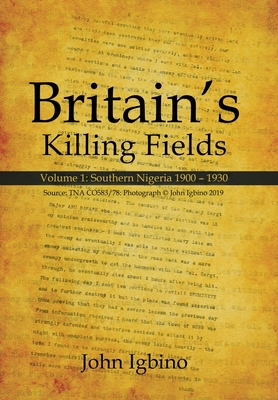Britain's Killing Fields: Volume 1: Southern Nigeria 1900 - 1930

Britain's Killing Fields: Volume 1: Southern Nigeria 1900 - 1930
Britain kept meticulous records of its casualties in Southern Nigeria, but it did not collect and keep any coherent records of the casualties it inflicted on the so-called natives. Britain's failure to collect and keep "natives"' casualty statistics was not an unconscious omission. Instead it was a deliberate policy because it placed considerably less value on the lives of "natives" compared to European lives. It held that a drop of European blood was worth four times more than "natives'" blood. The death of a District Officer on active duty was worth the lives of up to two hundred "natives" and it took twenty "natives" to service a Political Officer on the field. Additionally, it accepted the arguments of its top commander, Colonel Arthur Montanaro, that "natives" were engaged in illegal resistance to His Majesty's Government, therefore while he had a duty to crush their resistance to the British Government he was not duty bound to account for their deaths. Accordingly, the book explores these untold aspects of British History, particularly the computation of the number of Indigenous people of the landmass which became Southern Nigeria who were killed between 1900 and 1930 during one of the bloodiest periods in the history of Southern Nigeria as British troops of the West African Frontier Force (WAFF) and the West African Service Brigade (WASB) rampaged through Southern Nigeria. In its explorations the book posed and addressed the following questions: how many Indigenous people of Southern Nigeria were killed by the British Army between 1900 and 1930? What were the names of the people who were killed? Were there women and children among the dead? How old were they when they died? Where were they buried? Who buried them there? What were the prevailing political circumstances when they were killed? Under what military circumstances were they killed? Was there a state of war between the Indigenous people of Southern Nigeria and Britain when they were killed? The book's sources were unpublished original archival documents at the National Archives. These document sources included Ordinances, Proclamations, Admiralty's and Crown Agents' papers, High Commissioners', Governor-General's and Lieutenant-Governor's Correspondences and Despatches. The Correspondences and Despatches included field reports compiled by British Army Officers, Field Commanders, British Police Commissioners, Political Officers, District Officers (DO), District Commissioners, Divisional
PRP: 338.33 Lei
Acesta este Prețul Recomandat de Producător. Prețul de vânzare al produsului este afișat mai jos.
304.50Lei
304.50Lei
338.33 LeiLivrare in 2-4 saptamani
Descrierea produsului
Britain kept meticulous records of its casualties in Southern Nigeria, but it did not collect and keep any coherent records of the casualties it inflicted on the so-called natives. Britain's failure to collect and keep "natives"' casualty statistics was not an unconscious omission. Instead it was a deliberate policy because it placed considerably less value on the lives of "natives" compared to European lives. It held that a drop of European blood was worth four times more than "natives'" blood. The death of a District Officer on active duty was worth the lives of up to two hundred "natives" and it took twenty "natives" to service a Political Officer on the field. Additionally, it accepted the arguments of its top commander, Colonel Arthur Montanaro, that "natives" were engaged in illegal resistance to His Majesty's Government, therefore while he had a duty to crush their resistance to the British Government he was not duty bound to account for their deaths. Accordingly, the book explores these untold aspects of British History, particularly the computation of the number of Indigenous people of the landmass which became Southern Nigeria who were killed between 1900 and 1930 during one of the bloodiest periods in the history of Southern Nigeria as British troops of the West African Frontier Force (WAFF) and the West African Service Brigade (WASB) rampaged through Southern Nigeria. In its explorations the book posed and addressed the following questions: how many Indigenous people of Southern Nigeria were killed by the British Army between 1900 and 1930? What were the names of the people who were killed? Were there women and children among the dead? How old were they when they died? Where were they buried? Who buried them there? What were the prevailing political circumstances when they were killed? Under what military circumstances were they killed? Was there a state of war between the Indigenous people of Southern Nigeria and Britain when they were killed? The book's sources were unpublished original archival documents at the National Archives. These document sources included Ordinances, Proclamations, Admiralty's and Crown Agents' papers, High Commissioners', Governor-General's and Lieutenant-Governor's Correspondences and Despatches. The Correspondences and Despatches included field reports compiled by British Army Officers, Field Commanders, British Police Commissioners, Political Officers, District Officers (DO), District Commissioners, Divisional
Detaliile produsului










